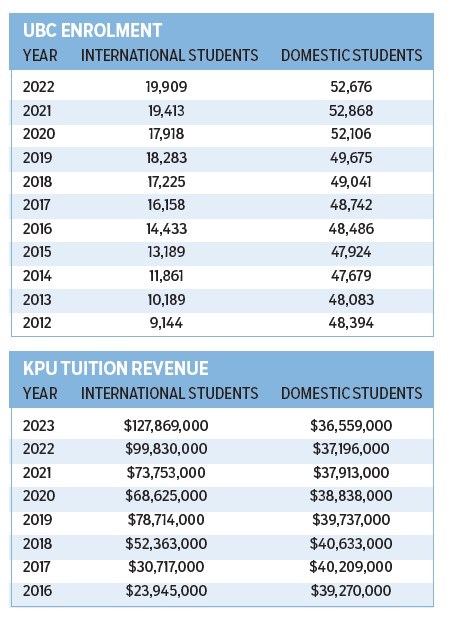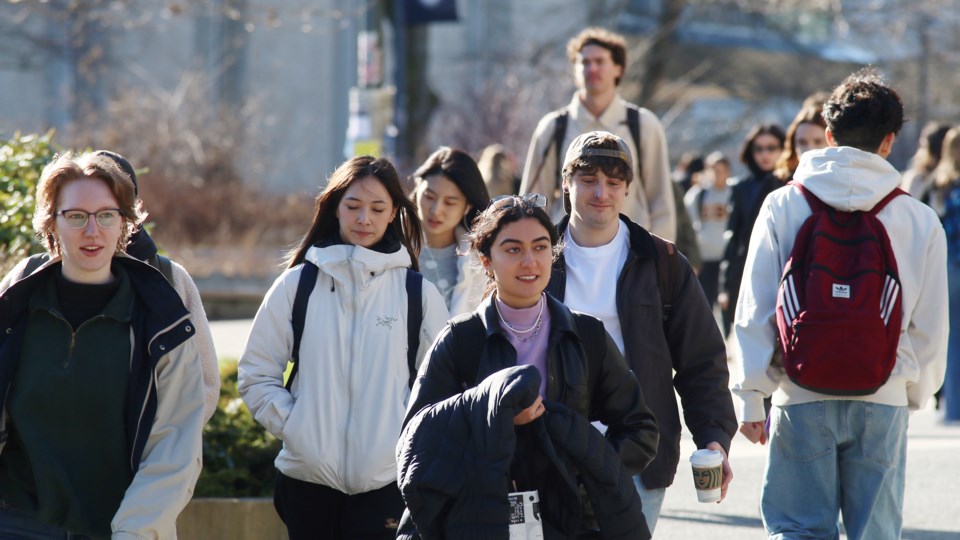If the federal government’s two-year cap on international students were applied equally to post-secondary institutions across Canada, some leading universities in B.C. could face losses of tens of millions of dollars in revenue annually.
Ottawa announced in January its plan to limit the number of new undergraduate study permits issued in 2024 to 360,000—a 35-per-cent decrease over 2023.
The province announced on March 1 its allocation allows for 83,000 undergraduate study permit applications, which is expected to result in about 50,000 approved study permit applications for 2024 based on previous acceptance rates, a 17-per-cent decrease from 2023.
Government has yet to announce how these allocations will be distributed across post-secondary institutions.
Public post-secondary institutes are expected to be less impacted than private ones, which will receive 27 per cent fewer study permit applications in 2024 than they did in 2023, according to the B.C. government.
BIV examined the enrolment patterns of international students at some of the province’s leading universities, and the revenue those students have generated over the past decade. While domestic student growth has been steady, the number of international students surged during the period, and more than doubled at some universities.
Soaring enrolment and ongoing increases in international tuition have made international students the main driver of revenue growth for some of the post-secondary institutes in B.C. In total, they represent up to 78 per cent of total tuition revenue.
“The cap will have far-reaching effects on Canadian communities, given that international students play a pivotal role in bolstering the economy by contributing over $22 billion a year to our country,” wrote Universities Canada and Colleges and Institutes Canada in a public letter to Marc Miller, federal minister of immigration in January.

International enrollment doubled in some B.C. universities
Among the five highest ranked post-secondary institutions in B.C., the University of British Columbia (UBC), including both its Â鶹´«Ã½Ó³»and Okanagan campuses, has seen the largest increase in international student enrolment and revenue over the 10-year period ended in 2022-23.
In 2012, there were 9,144 international students enrolled at UBC, making up 16 per cent of total enrolment. And in 2022, international enrolment grew to 19,909—more than doubling the 2012 figure and representing 27 per cent of total enrolment.
During this time, domestic students at UBC increased by less than nine per cent to 52,676 in 2022.
Tuition for international students is usually much higher than the tuition paid by domestic students, because tuition for the former isn’t regulated like it is for the latter. International undergraduate students at UBC, for example, now pay almost eight times more than their domestic classmates— and their financial contribution is even more significant.
UBC expected that revenue from international tuition in 2022-23 will reach $633 million, accounting for more than 60 per cent of total tuition revenue, according to the university’s financial report. This means an international student cap could lead to tens, if not hundreds of millions of dollars in losses for the university per year.
“UBC has long been an attractive study destination for international students,” wrote UBC in a statement to BIV.
“Our international students and colleagues have helped propel UBC’s excellence in research, teaching and learning such that UBC is consistently ranked among the best in the world. This is a legacy of which we are proud and that we are keen to preserve.”
Another leading university, Simon Fraser University (SFU), saw a steadier increase in international students over the same decade. This cohort grew from 5,359 in 2012—or 18 per cent of total number of students—to 6,416 in 2023, or 21 per cent. This generated around $140 million in undergraduate tuition in 2023, making up 44 per cent of total undergraduate tuition.
Meanwhile, the University of Northern British Columbia (UNBC) in Prince George had a humble start with 460 international enrolments in 2012 and this grew to 749 in 2023, representing around 20 per cent of total enrolment and contributing $7.1 million or 30 per cent of total tuition revenue.
The University of Victoria (UVic) saw international enrolment peak at 2,979 in 2015, making up around 15 per cent of total enrolment. Enrolment stayed at around 2,000 students per year, but has declined since the start of the pandemic, according to the university.
“UVic’s international undergraduate enrolment for 2023-24 is the lowest it has been in over 10 years, at 1,130 students, 11 per cent of the overall student population. Tuition from international students made up approximately 33 per cent of total tuition revenue,” said a statement from the university.
Likewise, the British Columbia Institute of Technology (BCIT) has also seen a drop in international enrolment since the pandemic started. After reaching 6,652 in 2019—around 10 per cent of total enrolment—international enrollment dropped to 3,423 in 2022, or seven per cent of total enrolment.
A university not among EduRank’s top five highest-ranked post-secondary institutions in B.C., but has been very popular among international students, is Kwantlen Polytechnic University (KPU). From 2018 to 2022, KPU’s number of international students grew from 4,967—23 per cent of total enrolment—to 8,003, or 38 per cent of total enrolment. International students contributed 78 per cent of the university’s total tuition revenue in 2022-23—$127.9 million.
“International tuition and student fees is the university’s largest revenue source,” said KPU’s annual financial report for the 2023 fiscal year.
Economic impact on B.C. universities uncertain
Data shows that over the past decade, some leading universities in B.C. have become highly reliant on international students to drive enrolment and revenue growth, which means that Ottawa’s international student cap can have a significant financial impact on the province’s post-secondary institutions.
The universities that responded to BIV said they are still waiting for more details on the changes and that it is too early to speculate on the economic impact of the cap.
“We don’t want to see harm caused to well-established institutions that are diligent and thoughtful in their approach to international student recruitment and retention,” said Alan Davis, KPU president and vice-chancellor.
“There are many details that are still being worked out at both levels of government and we continue working to identify, clarify and reduce any potential impact to KPU.”
The new provincial attestation letter system for new study permit applicants was effective March 4. The system distributes 53 per cent of letters to public post-secondary institutions and 47 per cent to private ones, to allow public post-secondary institutions “with sustainable international enrolment” to maintain their international student programs, according to the province.
Post-secondary institutions that have a higher percentage of international students could be affected more than others, according to Rahim Somani, vice-president of finance and administration at UNBC.
“When the ministry and the institutions are looking at their ability to continuously provide services, for the quality of experience, I think any numbers above 35 or 40 per cent starts becoming an area of concern. So in terms of the proportion of international students I think UNBC is currently situated in a reasonable place,” Somani said.
“Many of the details are still being worked out and our teams are working with [post-secondary organizations] to learn and then work out the next step, but we are expecting that we may still continue to see a steady growth and enrichment within the context of UNBC.”
twitter.com/Xiong_Daisy



